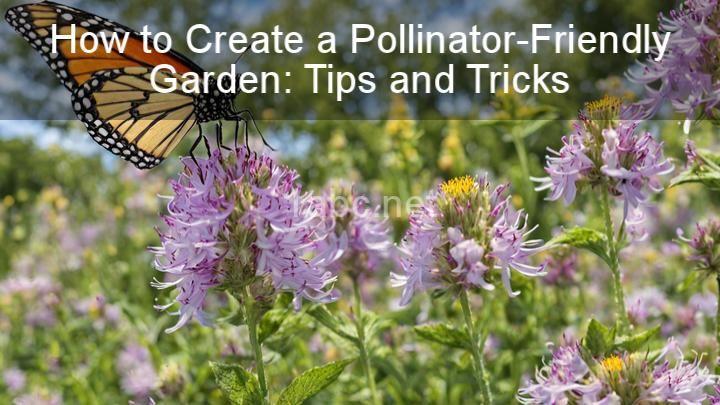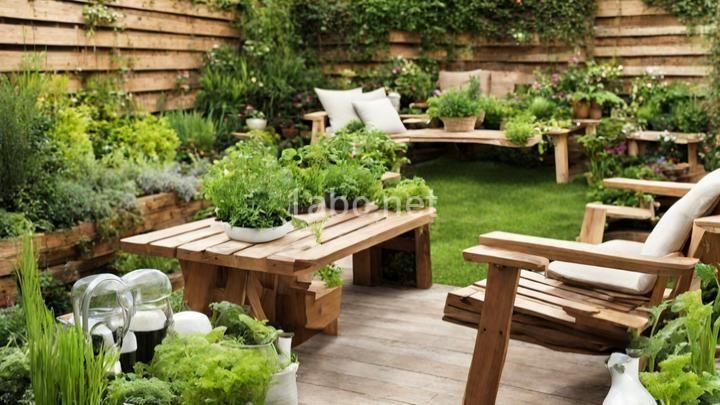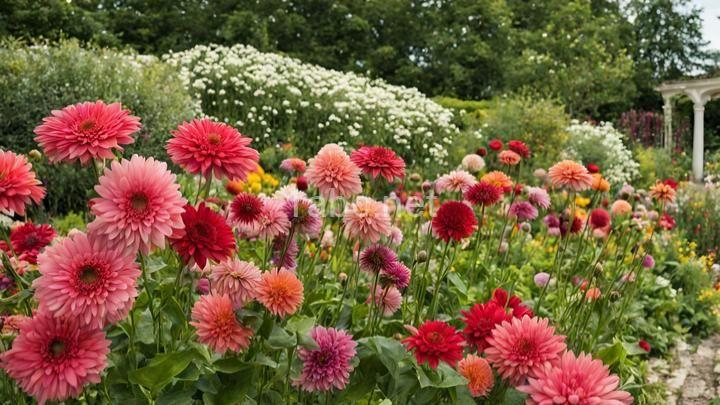How to Create a Pollinator-Friendly Garden: Tips and Tricks

Introduction:
Welcome readers to the blog post
Hello and welcome to our blog post on how to create a pollinator-friendly garden! We are so excited to share with you some tips and tricks that will help you transform your garden into a haven for pollinators. Pollinators, such as bees, butterflies, birds, and bats, play a vital role in our garden ecosystems. They are responsible for pollinating flowers, which leads to the production of fruits, seeds, and new plants. Without pollinators, our gardens would lack biodiversity and our crop yields would suffer. So, let's dive in and learn how to create a garden that is not only beautiful but also beneficial for pollinators!
I. Understand the Importance of Pollinators
To truly appreciate the significance of creating a pollinator-friendly garden, it's important to understand what pollinators are and the role they play in plant reproduction. Pollinators are animals that transfer pollen from the male parts of a flower to the female parts, allowing plants to reproduce. Bees, butterflies, moths, birds, bats, and even some beetles are examples of pollinators. Each type of pollinator has a unique way of pollinating, and this diversity is essential for the successful reproduction of many plants.
Did you know that bees, our most well-known pollinators, have been around for millions of years? They are incredibly efficient pollinators because they have specialized body parts that allow them to collect and transport pollen easily. Butterflies, on the other hand, are known for their vibrant colors and delicate wings. They are attracted to flowers with bright, showy petals and they sip nectar through a long proboscis. Birds, such as hummingbirds, are attracted to red and tubular-shaped flowers, while bats are attracted to night-blooming flowers with a strong fragrance. By attracting a diverse range of pollinators to your garden, you are not only ensuring the survival of these species but also increasing the biodiversity of your garden ecosystem.
II. Choose Plants that Attract Pollinators
Now that we understand the importance of pollinators, let's discuss how to attract them to our gardens. One of the first steps is to choose plants that are known to attract pollinators. Native plants, in particular, are highly preferred by pollinators because they have co-evolved with local pollinators and provide the right type of food and habitat. Native plants also tend to be well-adapted to the local climate, making them more resilient and easier to maintain.
When selecting plants, it's important to choose a variety of flowers, shrubs, and trees that bloom at different times throughout the year. This will ensure a continuous food source for pollinators. Different pollinators are attracted to different flower shapes and colors, so aim for a diverse range of plants. For example, bees are attracted to flowers with a landing platform, while butterflies are attracted to flowers with flat surfaces. By providing a variety of plant species, you will be able to attract a wider range of pollinators to your garden.
III. Provide Food and Water Sources for Pollinators
In addition to choosing the right plants, it's important to provide a diverse food source for pollinators. Nectar-producing flowers are a great source of food, but it's also important to provide pollen for bees and other insects. Pollen is a rich source of protein that is essential for the growth and development of bee larvae. By planting a variety of flowering plants, you will ensure a steady supply of nectar and pollen throughout the year.
To ensure continuous nectar availability, consider planting flowers with staggered bloom times. This way, there will always be something in bloom to attract pollinators. Additionally, providing water sources is crucial for pollinators, especially during hot and dry periods. Shallow bowls or birdbaths with stones for perching can serve as simple and effective water sources for pollinators.
IV. Create Suitable Habitats for Nesting and Shelter
To create a truly pollinator-friendly garden, it's important to provide nesting spots and shelter for different pollinator species. Bees, for example, require nesting spots to lay their eggs and raise their young. Bee houses or bee hotels can be easily installed in your garden to provide nesting sites for solitary bees. These structures consist of wooden blocks with pre-drilled holes that mimic the natural nesting sites of bees.
Butterflies, on the other hand, require sheltered spots to rest and protect themselves from predators. Butterfly shelters, such as small brush piles or dense shrubs, can provide the perfect hiding spots for butterflies. Similarly, bird boxes can be installed to provide nesting spots for birds that visit your garden.
It's also important to leave some natural debris or dead wood in your garden. This provides shelter for various pollinator species, including beetles and other insects. By creating a habitat that mimics nature, you will not only attract pollinators but also contribute to the overall biodiversity of your garden.
V. Avoid Harmful Chemicals in Your Garden
Creating a pollinator-friendly garden goes beyond selecting the right plants and providing food and shelter. It also involves adopting practices that are safe for pollinators. One of the biggest threats to pollinators is the use of pesticides. Pesticides, such as insecticides and herbicides, can be harmful to pollinators when they come into contact with them or consume contaminated nectar and pollen.
To protect pollinators, it's important to avoid using harmful chemicals in your garden. Instead, consider alternative methods such as companion planting, which involves planting certain flowers or herbs that repel pests or attract beneficial insects. Natural pest control techniques, such as handpicking pests or using organic insecticides, can also be effective in managing garden pests without harming pollinators.
Organic gardening practices, such as enriching the soil with compost and using natural fertilizers, can also promote a healthy ecosystem in your garden. By avoiding harmful chemicals, you are creating a safe and welcoming environment for pollinators.
VI. Maintain Your Pollinator-Friendly Garden
Creating a pollinator-friendly garden is an ongoing process that requires regular maintenance. Here are a few tips to help you maintain your garden:
- Weeding: Regularly remove weeds from your garden, as they can compete with your flowering plants for resources.
- Watering: Water your plants regularly, especially during dry periods, to ensure they have enough moisture.
- Mulching: Mulch around your plants to help retain moisture, suppress weeds, and regulate soil temperature.
- Observation: Take the time to observe and enjoy the pollinators in your garden. By observing their behavior, you can learn more about their preferences and make adjustments to better cater to their needs.
- Join gardening communities or organizations: Consider joining local gardening communities or organizations that focus on pollinator conservation. These groups can provide further learning opportunities and support.
Conclusion:
In this blog post, we have explored the importance of creating a pollinator-friendly garden and provided tips and tricks to help you achieve this goal. By understanding the role of pollinators, choosing the right plants, providing food and water sources, creating suitable habitats, avoiding harmful chemicals, and maintaining your garden, you can create a garden that not only looks beautiful but also supports pollinators and promotes biodiversity. We hope that you are inspired to take action and create a garden that will be buzzing with life! We would love to hear about your experiences or answer any questions you may have, so please feel free to share in the comments section below. Happy gardening!
FREQUENTLY ASKED QUESTIONS
What is a pollinator-friendly garden?
A pollinator-friendly garden is a garden that is intentionally designed and maintained to attract and support pollinators such as bees, butterflies, birds, bats, and other insects. These gardens provide essential food, water, shelter, and breeding sites for pollinators, helping to promote their health and population. Pollinator-friendly gardens typically include a variety of nectar-rich flowers, flowering plants, and trees, as well as native plant species that are well-suited for the local environment. They also minimize or avoid the use of pesticides, provide nesting sites, and have a continuous bloom throughout the growing season to ensure a constant food source for the pollinators. Creating a pollinator-friendly garden not only benefits the pollinators but also contributes to a healthier and more diverse ecosystem.
Why should I create a pollinator-friendly garden?
Creating a pollinator-friendly garden is beneficial for several reasons:
- Support for pollinators: Pollinators, such as bees, butterflies, and birds, play a crucial role in the ecosystem by pollinating plants. By creating a garden that provides them with habitat and food sources, you contribute to the conservation of these important species.
- Biodiversity: A pollinator-friendly garden attracts a diverse range of pollinators, leading to increased biodiversity in your outdoor space. This can help create a balanced and sustainable ecosystem.
- Enhanced plant reproduction: Pollinators facilitate the transfer of pollen from the male part of a flower to the female part, leading to successful plant reproduction. By creating a garden that supports pollinators, you increase the chances of successful pollination, resulting in healthier plants and higher crop yields.
- Beauty and aesthetics: Pollinator-friendly gardens are often colorful and full of life. By incorporating a variety of flowering plants, you can create a visually appealing and vibrant garden that is a joy to behold.
- Educational opportunities: A pollinator-friendly garden provides a valuable educational resource, especially for children. It offers opportunities to learn about the importance of pollinators, their life cycles, and their interactions with plants.
Overall, creating a pollinator-friendly garden is a way to contribute to environmental conservation while enjoying the beauty and benefits that a diverse ecosystem brings.
How do pollinators benefit my garden?
Pollinators play a crucial role in the health and success of your garden. Here are some benefits they provide:
- Pollination: Pollinators like bees, butterflies, and hummingbirds transfer pollen between flowers, which helps fertilize plants and facilitate fruit and seed production. This process is essential for the reproduction of many flowering plants.
- Increased Yield: With pollinators visiting your garden, you can expect increased fruit and vegetable yields. These beneficial insects ensure that plants are properly pollinated, leading to more abundant crops.
- Biodiversity: By attracting pollinators to your garden, you encourage a diverse range of species. This biodiversity helps maintain a healthy ecosystem and promotes the overall balance of flora and fauna.
- Plant Reproduction: Without pollinators, certain plants would struggle to reproduce or may become extinct. Pollinators ensure the survival of many plant species by transferring pollen from male to female plant parts.
- Habitat Support: Building a pollinator-friendly garden provides habitats for these vital creatures. By planting diverse flowering plants, providing water sources, and avoiding the use of pesticides, you create a safe space for pollinators to nest, feed, and reproduce.
So, by supporting pollinators in your garden, you not only enhance your plants' productivity but also contribute to the well-being of the ecosystem around you.
What are some essential features of a pollinator-friendly garden?
A pollinator-friendly garden is designed to attract and support various pollinators such as bees, butterflies, and birds. Some essential features to consider are:
- Native plants: Incorporate a variety of native plants in your garden as they are adapted to the local ecosystem and provide food and habitat for pollinators.
- Blooming flowers: Choose flowers that bloom throughout the growing season to provide a continuous source of nectar and pollen for pollinators.
- Diversity: Aim for a diverse range of plant species with different sizes, shapes, and colors to attract a wide array of pollinators.
- Shelter and nesting sites: Create habitat features like bushes, shrubs, and trees to provide shelter, nesting sites, and protection from predators for pollinators.
- Water sources: Include a water feature such as a shallow dish, bird bath, or small pond to provide a water source for pollinators.
- Avoid pesticides: Minimize or eliminate the use of pesticides as they can harm pollinators. If necessary, explore organic and environmentally-friendly alternatives.
- Avoid invasive plants: Avoid planting invasive plant species, as they can outcompete native plants and disrupt the natural ecosystems.
- Maintenance: Regularly maintain your garden by pruning, weeding, and mulching to keep it healthy and attractive to pollinators.
Remember, creating a pollinator-friendly garden not only benefits these important creatures but also adds beauty and vibrancy to your outdoor space.

